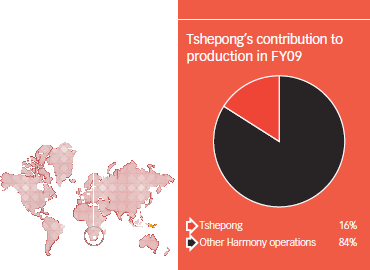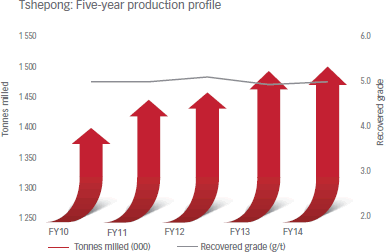Contents
- Corporate profile
- Key statistics 2009
- Key features 2009
- Operations at a glance
- FY09 – milestones
- Harmony strategy
- Chairman’s letter
- Chief executive officer’s review
- Review of operations
- Exploration overview
- Mineral resources and ore reserves
- Board of directors
- Executive management
- Corporate governance
- Directors’ report
- Report of the independent auditors (PDF - 37KB)
- Group annual financial statements (PDF - 312KB)
- Company annual financial statements (PDF - 123KB)
- Statement of subsidiary companies (PDF - 48KB)
- Investor relations
- Glossary of terms
- Administrative information
Tshepong

![Tshepong location [SA map]](i/sa_tshepong.gif)
Description
Located in the Free State, near Odendaalsrus, Tshepong comprises a single vertical shaft extending to a depth of 2 154 metres. Ore is transported to the Harmony 1 plant, located some 23 kilometres away. The Tshepong sub-66 decline project which will extend mining to a depth of 2 490 metres, is currently building up production and the Sub-71 decline project is in progress.
Harmony initially acquired Tshepong as part of the acquisition, in a 50:50 joint venture with ARMgold, of the Freegold operations from AngloGold Ashanti Limited in January 2002. In September 2003, Harmony acquired these operations in their entirety.
The mine undertakes conventional undercut mining on the Basal Reef. The B reef is exploited as a high grade secondary reef.
In FY09, Tshephong employed 4 856 people – 4 720 employees and 136 contractors.
Mineral resources and ore reserves
Exploration on the B reef is being undertaken at Tshephong, with three particular target areas having been identified, namely Horizon, Midas and Leeuwbosch. While the B reef is a highly erratic orebody, current indications are that this reef has excellent potential from a grade point of view.
At the end of June 2009, Tshepong reported ore reserves of 4.314 million ounces of gold and mineral resources of 14.082 million ounces. The operation’s current expected life-of-mine is 17 years. See the mineral resources and ore reserves section (PDF - 108KB) for more detail.
| Tshepong | Mineral resources | Ore reserves | |||||
| Measured | Indicated | Inferred | Total | Proven | Probable | Total | |
|---|---|---|---|---|---|---|---|
| Oz (000) | 4 949 | 5 211 | 3 922 | 14 082 | 2 184 | 2 130 | 4 314 |
| Tonnes (Mt) | 14.0 | 14.3 | 13.8 | 42.1 | 12.8 | 11.5 | 24.3 |
| Grade (G/t) | 11.03 | 11.32 | 8.85 | 10.42 | 5.30 | 5.78 | 5.53 |
Safety
Safety performance at Tshepong was of grave concern in FY09. Regrettably there were seven fatalities (FY08: 2), five of which were outside the stoping areas and in areas that would generally be considered lower risk. A behaviour-based safety programme has been implemented to promote safety awareness, particularly in the services areas, so as to address this issue.
The FIFR per million hours worked for the year was 0.62 (FY08: 0.17), while the LTIFR improved by 15% to 15.18, the best LTIFR performance reported by the mine (FY08: 18.52).
![Tshepong FIFR (per million hours worked) [graph]](i/tsh_fifr.gif)
![Tshepong LTIFR (per million hours worked) [graph]](i/tsh_ltifr.gif)
Tshepong key statistics:
| Unit | FY09 | FY08 | FY07 | |
|---|---|---|---|---|
| Production | ||||
| Volumes milled | 000 t (metric) | 1 375 | 1 495 | 1 654 |
| 000 t (imperial) | 1 516 | 1 649 | 1 824 | |
| Gold produced | kg | 7 178 | 8 271 | 9 928 |
| oz | 230 778 | 265 914 | 319 192 | |
| Average grade | g/t | 5.22 | 5.53 | 6.00 |
| oz/t | 0.152 | 0.161 | 0.175 | |
| Financial | ||||
| Revenue | R million | 1 780 | 1 621 | 1 460 |
| US$ million | 198 | 223 | 230 | |
| Cash costs | R/kg | 139 901 | 105 800 | 83 220 |
| US$/oz | 483 | 455 | 360 | |
| Cash operating profit | R million | 802 | 715 | 653 |
| US$ million | 89 | 98 | 91 | |
| Capital expenditure | R million | 249 | 195 | 188 |
| US$ million | 28 | 27 | 26 |
Tshepong key quarterly indicators:FY09
![Tonnes (000) [graph]](i/tsh_ton.gif)
![Grade (g/t) [graph]](i/tsh_grade.gif)
![Gold produced (kg) [graph]](i/tsh_gold.gif)
![Cash cost (R/kg) [graph]](i/tsh_cost.gif)
![Cash profit (R000) [graph]](i/tsh_cash.gif)
The year in review
Tshepong endured a very difficult year, but remained the largest contributor to Harmony’s profit despite these business interruptions.
Volumes declined at Tshepong, by 8% to 1 375 000 tonnes as a series of operational, infrastructural and safety-related problems affected the mine. These included a fire in the first quarter that affected 18 panels for a period of a week and onstrained flexibility during the year, safety-related stoppages, a power supply failure and a labour go-slow in the second quarter. By the fourth quarter some improvement in volumes were seen.
Management spent much time during the year addressing industrial relations issues; these were largely resolved by yearend. The self-directed work team training that was originally pioneered at Tshepong has been reintroduced.
The average grade declined by 6% to 5.22 g/t. This was primarily as a result of two factors, namely:
- Mining is currently taking place at the edge of the orebody’s main pay shoot, where grades are more variable. Once the Sub 66-decline project has been completed, mining will move into higher-grade, less variable grade zones and grades are expected to rise from FY11/FY12.
- Off-reef mining in the lower grade north-west area, particularly in the fourth quarter, was higher than planned.
To mitigate against this grade decline, Tshepong has focussed on quality mining, with attention being paid to improved sweepings, and reduced off-reef mining and stoping widths. By its nature the under-cut mining method employed at Tshepong results in the liberation of gold from finely fragmented ore. Historically, the mine call factor (MCF) at Tshephong has been low. Pleasingly, the MCF improved year-on-year from 62% to 67%. The full commissioning of the belt level in the sub-66 decline will also result in higher grades being achieved.
The lower volumes mined and declining grade resulted in gold production falling by 13% to 7 178 kilograms (230 778 ounces).
To improve flexibility, particular emphasis was placed on development in the second half of the year. Other key issues that are being addressed by this mine to return it to optimal performance are the performance of the refrigeration plant and pumping infrastructure.
Cash costs, at R139 901/kg (US$483/oz) were 32% up in rand terms, but Tshepong remains the second lowest-cost producer in the Harmony stable.
Given the proximity of Tshepong to Phakisa, there are access, ventilation and service synergies that can be exploited to allow access at depth. The sub-66 decline was completed during the year and is currently in a build-up phase. Work on the sub-71 decline, which was temporarily suspended owing to poor ground conditions, has resumed.
Tshepong reported a cash operating profit of R802 million (US$89 million) for the year (FY08: R715 million). Capital expenditure of R249 million (US$28 million) was 28% higher.
Outlook*
Tshepong will not achieve its reserve grade until the mine is fully able to access the orebody through the declines. Volumes are expected to rise in to 1 402 000 tonnes in FY10, while grade will decline to 5.02 g/t. Gold production of some 7 031 kilograms (226 000 ounces) is planned, with cash costs** of R152 000/kg (US$525/oz) anticipated.
Total capital expenditure** planned for FY10 is R243 million (US$31 million) – R157 million (US$20 million) on on-going development, R16 million (US$2 million) on major equipment maintenance and R25 million (US$3 million) on other shaft capital. The balance of R45 million (US$6 million) is planned for the Sub-71 decline project.
* Please refer to the forward-looking statements (PDF - 54KB)
** June 2009 money terms. The exchange rate as at 30 June 2009 of R7.72/US$ has been used for all forward-looking conversions.

The B Reef Project
![The B Reef Project [diagram]](i/tsh_reefmap.gif)
A four-year, R56 million (US$6.2 million) exploration development programme to investigate the B Reef orebody and prove up this resource in the Leeuwbosch area north-east of Tshepong has begun. This project will include 5.5 kilometres of underground development over two levels, 1 700 metres below surface. In FY09, the first year of this project, initial drilling yielded positive results which were confirmed by preliminary underground drilling results that exceeded expectations. Small-scale mining of the B Reef on the west side of Tshepong indicates viable payshoots. This project is being undertaken at a total cost of R55 million (US$6.4 million). First gold production from the Leeuwbosch and B Reef areas could be achieved by July 2013.
Tshepong Sub-71 Decline
Given the proximity of Tshepong to Phakisa and the access to the orebodies below 66 level at both mines, there are access, ventilation and service synergies that can be exploited. The sub-66 decline was completed during the year and is currently in a build-up phase. The sub-71 project is currently under way. This will connect Tshepong with 75 level at Phakisa, which is the starting level of the Phakisa decline system to 81 level.
Work on this project was temporarily suspended during the year owing to poor ground conditions. Following the complete resupport of the area, work has now resumed.
The project is being undertaken at a total cost of R174 million (US$20 million), of which R74 million (US$5.5 million) has been spent to date. This project will be completed in October 2011. The diagrams below give an indication of the scope of the project.
![Tshepong Sub-71 Decline [diagram]](i/tsh_sub71a.gif)
![Tshepong Sub-71 Decline [diagram]](i/tsh_sub71b.gif)

